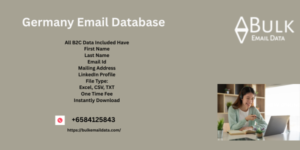To make charts and histograms easy to read, add explanatory text: titles, comments. The title should contain the main idea: what exactly the data shows and how they are related to each other.
Comments should explain the visual in more Germany Email Database detail. For example, if you show an increase in the number of completed orders, indicate possible reasons for the increase: seasonality, new routes, advertising campaign.
Headlines, captions, and comments help readers quickly get into context.
We talked about the optimal layout of letters in more detail in our blog: “ A guide to the layout of letters for email marketers: types, possibilities, checking for correctness, common mistakes .”
A Guide to Email Layout for Email Marketers: Types, Possibilities, Correctness Check, Common Mistakes
A Guide to Email Layout for Email Marketers: Types, Possibilities, Correctness Check, Common Mistakes
3. One diagram - one idea
To compare sales of four products over the last three months, it's best to create a chart for each product. Trying to show everything at once will make the graph cluttered and hard to read, especially on mobile devices.
Visualization standards
Place visual elements in a familiar way so that the reader can intuitively understand everything:
A chart or histogram is read from left to right. Therefore, the time axes - years, months, quarters - are placed horizontally from left to right. For example, to show the dynamics of sales from January to December;
Quantitative indicators should be located on the vertical axis. For example, to show sales volume in units or monetary equivalent;
Use contrasting colors without gradients, shadows, and other Purchase Email Leads unnecessary elements to avoid overloading the visual. For example, blue for product A sales, red for product B.
Use color coding correctly. Usually green, blue and yellow shades are used for positive values of growth, profit. Red and gray - for negative.
5. Optimal image size and weight
Images that are too small are difficult to read, while images that are too large take a long time to load and often require horizontal scrolling left and right. All of this is irritating to the user.
To prevent this from happening, the diagram or histogram in the newsletter should take up no more than 60% of the screen width on most devices — about 600 pixels. This way, the reader will see the entire image at once.
The height should be proportional to the width to maintain readability and visual appeal. A chart that is too tall may not display well on mobile devices.
The optimal image size is 100–200 KB. Heavier images will not open immediately, especially with a weak Internet connection.
6. Testing
Before final sending, it is better to send a letter with the visual to yourself or colleagues. This way you can make sure that the diagram or histogram is displayed correctly on different devices.
What services can you use to make diagrams and histograms yourself?
Here is a brief overview of services that will help you visualize data without programming skills.
Google Sheets
To use this free tool, sign in to your Google account and select Google Sheets. Then create a table with the data you want to visualize.
Select the columns you want to convert into a chart or histogram. Then find the menu tab "Insert" → "Chart". The service will offer the best chart for your data, but you can customize it as you wish.
An example of a chart you can create in Google Sheets
An example of a chart you can create in Google Sheets
Data wrapper
This is an online service in English. It allows you to create bar and line charts.
The platform imports data from various sources: Excel, CSV, Google Sheets, etc. This simplifies the work because there is no need to format anything in advance.
The settings allow you to change colors, fonts, scale and other parameters.
In the preview, you can check the display of the diagram on different devices: phone, tablet, computer. And if necessary, immediately adjust the size or reduce the amount of data in the graph if it is difficult to read.

Comments on “How to Add a Chart and Bar Graph to Your Email Newsletter: A Basic Guide”